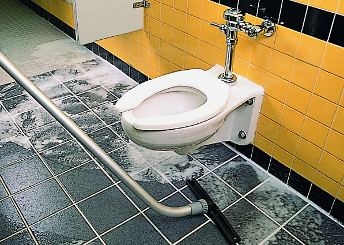|
|
| The Pink, the Blue, and the Yellow |
| By Robert Kravitz, President AlturaSolutions |
| Published: 04/20/2015 |
 You never know who out there is blogging and what they might be blogging about. But you can imagine, there are people and organizations blogging about just about everything and this includes many former inmates.
One male inmate started a blog back in November 2009. It details his experience staying in a county jail where he had a cell with his own toilet, sink, and shower. He discusses how fastidious he was, cleaning and maintaining his cell and his personal bathroom. However, things changed and changed rather dramatically when he was moved to a state correctional facility. Now he was bunking down in a dorm-like setting with 60 other inmates, all of whom shared a mini locker-room with toilets, sinks and showers.
You never know who out there is blogging and what they might be blogging about. But you can imagine, there are people and organizations blogging about just about everything and this includes many former inmates.
One male inmate started a blog back in November 2009. It details his experience staying in a county jail where he had a cell with his own toilet, sink, and shower. He discusses how fastidious he was, cleaning and maintaining his cell and his personal bathroom. However, things changed and changed rather dramatically when he was moved to a state correctional facility. Now he was bunking down in a dorm-like setting with 60 other inmates, all of whom shared a mini locker-room with toilets, sinks and showers.
Now maintaining his high standards became much more of a problem. According to this inmate, the correctional officers would "draft" inmates to clean the restrooms. Most of them, as you can imagine, were not eager to perform this work and their lack of enthusiasm was often reflected in the job performed. However, our inmate often volunteered for restroom detail because as we know, a clean—even hygienically clean—restroom was pretty high on his list of "must haves" even in prison. "There were three basic items used in cleaning the restroom," according to this inmate. "The pink, the blue, and the yellow."
So what would be the proper equipment? Most likely this prison, like many more, has been cleaning their restrooms with "the pink, the blue, and the yellow" for decades. Correctional facilities have always been concerned about disease and the spread of infection, but along with using these old cleaning products, not being provided gloves or brushes to clean the inside of toilets certainly does not help situations. It might be time for correctional facilities around the country to reevaluate how their restrooms are being cleaned and look into ways to perform these tasks that are more sanitary, resulting in less chance of cross contamination, which can help keep the spread of disease among inmates to a minimum. Many restroom cleaning technologies have been introduced over the past twenty years that can accomplish this. For instance, if 60 men are sharing the same restroom, it probably would be best to eliminate cleaning restrooms, restroom fixtures, tile and grout, as well as floors, by hand. Manual cleaning, at this point, is the least effective and slowest way to clean restrooms. While the amount of time it takes to clean the restrooms may not be of high concern for correctional administrators, the effectiveness of the cleaning—and its significant role in helping prevent the spread of disease—certainly is. So what are the options? The options involve automating the restroom cleaning process. One way is with the use of what are called spray-and-vac cleaning systems. The name was coined by ISSA, the worldwide cleaning association. Instead of pink, blue, or yellow cleaning solutions, a disinfectant cleaner can be used to help ensure germs and bacteria are eliminated in the cleaning process. Once the job is done, the machine vacuums up the solution, removing it from the floor so the restroom can be put back into service relatively quickly. Tests with these systems indicate that they are far more effective at reducing or eliminating contaminants on surfaces. While it is not encouraged or recommended especially in a correctional facility, some tests have even indicated that these systems clean effectively even without the use of cleaning solution. And we should point out something else. While it is recommended, as with all cleaning methods that gloves be worn, it is not a requirement. In fact, this is why some of the machines were originally introduced as "no-touch" cleaning machines. I'm sure gloves would have helped our blogging inmate mentioned earlier, but he would have appreciated being provided with access to any of these more modern cleaning methods even more. Editors Note: Corrections.com author, Robert Kravitz, is president of AlturaSolutions Communications and is a writer for the professional cleaning, building, healthcare, and educational industries. He may be reached at rkravitz@rcn.com Other articles by Robert Kravitz |
Comments:
Login to let us know what you think
MARKETPLACE search vendors | advanced search

IN CASE YOU MISSED IT
|


Hello, Much work needs to be done at many schools that were affected badly by the floods such as the Paliyam Girls Higher Secondary School.